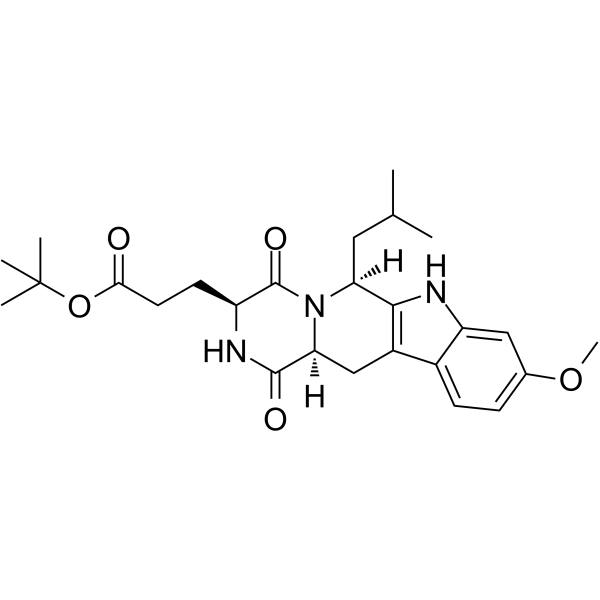上海金畔生物科技有限公司为生命科学和医药研发人员提供生物活性分子抑制剂、激动剂、特异性抑制剂、化合物库、重组蛋白,专注于信号通路和疾病研究领域。
Ko 143 纯度: 99.83%
Ko 143 是有效且选择性的 ATP 结合盒亚家族 G 成员 2 (ABCG2/BCRP) 抑制剂。Ko 143 比 P-gp 和 MRP-1 运输蛋白高出 200 倍的选择性。

Ko 143 Chemical Structure
CAS No. : 461054-93-3
| 规格 | 价格 | 是否有货 | 数量 |
|---|---|---|---|
| Free Sample (0.1-0.5 mg) | Apply now | ||
| 10 mM * 1 mL in DMSO | ¥980 | In-stock | |
| 5 mg | ¥949 | In-stock | |
| 10 mg | ¥1525 | In-stock | |
| 25 mg | ¥3600 | In-stock | |
| 50 mg | ¥6678 | In-stock | |
| 100 mg | ¥11476 | In-stock | |
| 200 mg | 询价 | ||
| 500 mg | 询价 |
* Please select Quantity before adding items.
Ko 143 相关产品
•相关化合物库:
- Bioactive Compound Library Plus
- Membrane Transporter/Ion Channel Compound Library
- Anti-Cancer Compound Library
- Lipid Metabolism Compound Library
| 生物活性 |
Ko 143 is a potent and selective ATP-binding cassette subfamily G member 2 (ABCG2/BCRP) inhibitor. Ko 143 displays >200-fold selectivity over P-gp and MRP-1 transporters[1][2]. |
IC50 & Target |
EC90: 26 nM (BCRP) |
||||||||||||||
|---|---|---|---|---|---|---|---|---|---|---|---|---|---|---|---|---|---|
| 体外研究 (In Vitro) |
Ko143 (10 nM) significantly decreases (2.5-fold) the IC50 of MTX for HEK G2 cells and mouse G2 cells. Ko143 (1-100 μM) metabolite does not inhibit the function of ABC Transporters[1]. Reversal of drug resistance in SKF 104864A-selected mouse MEF3.8/T6400 cells and human IGROV1/T8 cells by FTC analogue Ko143. Ko143 is applied at zero, one, or eight times the EC90 concentration of 25 nM[2]. Ko143 inhibits BCRP-mediated transport of ZD 4522 in Madin-Darby Canine Kidney (MDCK) 2-BCRP421CC (wild type) cells and MDCK2-BCRP421AA (mutant type) cells[3]. 上海金畔生物科技有限公司 has not independently confirmed the accuracy of these methods. They are for reference only. |
||||||||||||||||
| 体内研究 (In Vivo) |
Ko143 (10 mg/kg, p.o.) increases the oral availability of SKF 104864A in mice[2]. Ko143 significantly affects the pharmacokinetics of ZD 4522 in rats[3]. 上海金畔生物科技有限公司 has not independently confirmed the accuracy of these methods. They are for reference only. |
||||||||||||||||
| 分子量 |
469.57 |
||||||||||||||||
| Formula |
C26H35N3O5 |
||||||||||||||||
| CAS 号 |
461054-93-3 |
||||||||||||||||
| 运输条件 |
Room temperature in continental US; may vary elsewhere. |
||||||||||||||||
| 储存方式 |
|
||||||||||||||||
| 溶解性数据 |
In Vitro:
DMSO : 100 mg/mL (212.96 mM; Need ultrasonic) 配制储备液
*
请根据产品在不同溶剂中的溶解度选择合适的溶剂配制储备液;一旦配成溶液,请分装保存,避免反复冻融造成的产品失效。 In Vivo:
请根据您的实验动物和给药方式选择适当的溶解方案。以下溶解方案都请先按照 In Vitro 方式配制澄清的储备液,再依次添加助溶剂: ——为保证实验结果的可靠性,澄清的储备液可以根据储存条件,适当保存;体内实验的工作液,建议您现用现配,当天使用; 以下溶剂前显示的百
|
||||||||||||||||
| 参考文献 |
|
| Cell Assay [2] |
cells are plated at 400 or 1000/well in 96-well plates the night before addition of drugs. A concentration series of drug is applied along one plate axis and left for the duration of the assay. Plates are harvested after 4-5 days while untreated wells are still subconfluent. Relative cell proliferation is quantified with CyQuant or Sybr Green I fluorescent nucleic acid stains. Assays with human cell lines are performed in the presence of 0.1 μm PSC833 to inhibit confounding P-gp activity. 上海金畔生物科技有限公司 has not independently confirmed the accuracy of these methods. They are for reference only. |
|---|---|
| Animal Administration [2] |
Oral toxicity of FTC analogues in mice is tested by mixing 50 mg/mL stocks in DMSO 1:1 with Tween 80 (polyoxyethylene sorbitan mono-oleate) and diluting with 5% w/v glucose such that the final volume administered by oral gavage is 10 μL/g of body weight. Pairs of mice are administered oral doses of 50 mg/kg Ko132, Ko134, Ko143, or vehicle under light methoxyflurane anesthesia. Final tests of 50 mg/kg Ko134 or Ko143 are performed on additional pairs of unanesthetized animals to observe any behavioral effects. Further, another pair of mice receive the higher dose of 100 mg/kg Ko134. For i.p. toxicity tests, the FTC analogue stocks in DMSO are dispersed in at least 10 volumes of sterile corn oil such that the injected volume is 5 μL/g of body weight. After pilot tests at lower doses show no adverse effects, mice (4 per group) are administered vehicle or 10 mg/kg i.p. of Ko132, Ko134, or Ko143. The mice are observed continuously during the first hour after administration and then at increasing intervals for 2 weeks, after which they are sacrificed for histological examination of major organs and structures including brain, salivary glands, heart, lungs, liver, adrenal glands, kidneys, urinary tract, spleen, thymus, bone marrow, pancreas, stomach, intestines, cecum, colon, testes, epididymus, skin, head, trunk, and limbs. 上海金畔生物科技有限公司 has not independently confirmed the accuracy of these methods. They are for reference only. |
| 参考文献 |
|
所有产品仅用作科学研究或药证申报,我们不为任何个人用途提供产品和服务
